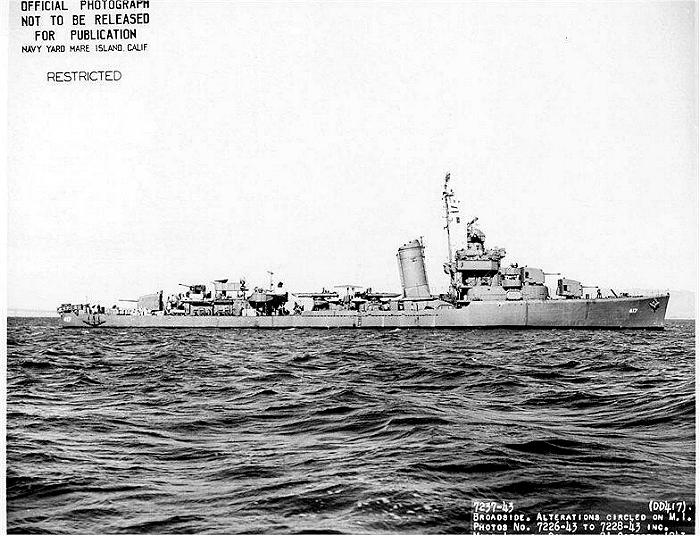

|
|
September 1942
USS Morris (DD-417) first found in USS Helena CL-50 War Diary for 2 September 1942,

USS Morris (DD-417), a World War II-era Sims-class destroyer in the service of the |
History
Builder: Norfolk Navy Yard, Portsmouth, Virginia
General characteristics
Class and type: Sims-class destroyer
Morris, flagship of Destroyer Squadron 2 (DesRon 2), followed her shakedown with routine
Attached to Task Force 17 (TF 17), the destroyer sailed on 16 March for Noumea, and into
Morris's next action came in late August, when she joined TF 61 in support of the Guadalcanal
In May 1943, Morris departed the southern Pacific and sailed north to support the capture and
Laid down: 7 June 1938
Launched: 1 June 1939
Commissioned: 5 March 1940
Decommissioned: 9 November 1945
Struck: 28 November 1945
Honors and
awards: American Defense Service Medal ("Fleet" clasp, "A" device),
Asiatic-Pacific Campaign Medal (15 stars), World War II Victory Medal
Fate: Sold on 2 August 1947, scrapped
Displacement:
1,570 long tons (1,600 t) (std)
2,211 long tons (2,246 t) (full)
Length: 348 ft, 3¼ in, (106.15 m)
Beam: 36 ft, 1 in (11 m)
Draft: 13 ft, 4.5 in (4.07 m)
Propulsion: High-pressure super-heated boilers,
geared turbines with twin screws, 50,000 horsepower
Speed: 35 knots
Range: 3,660 nautical miles at 20 kt (6,780 km at 37 km/h)
Complement: 192 (10 officers/182 enlisted)
Armament:
5 × 5 inch/38, in single mounts
4 × .50 caliber/90, in single mounts
8 × 21 inch torpedo tubes in two quadruple mounts
2 × depth charge track, 10 depth charges
training schedules until the summer of 1941 when she joined the North Atlantic Patrol. With
the entry of the United States into World War II, she entered Charleston Navy Yard, where
she was equipped with the first fire control radar for a destroyer. By 3 January 1942, she was
underway for Pearl Harbor, rejoining her squadron there at the end of February.
her first major enemy engagement, the Battle of the Coral Sea. Prior to the battle, she guarded
the carriers of the task force as their planes struck at enemy shipping in Tulagi Harbor and in
the Louisiade Archipelago. From 4-8 May, she splashed one enemy plane and damaged two
while screening Yorktown and Lexington, and when the latter was heavily damaged, pulled
alongside to rescue some 500 survivors. Damage received during the rescue forced her back
to Pearl Harbor where hurried repairs put her back into condition for the Battle of Midway a month
later. In that action she again pulled alongside Yorktown to rescue over 500 survivors.
Campaign. For the next 2 months, she screened carriers and patrolled among the Solomon Islands.
On 25 October, following a 3-day independent sweep through the Gilbert Islands, she rejoined
TF 17 and took part in the Battle of the Santa Cruz Islands. During the action, she destroyed six
aircraft and once more came to the rescue of Hornet, from which she took on 550 survivors. As
in other rescue operations her superstructure was damaged, but, after repairs at Espiritu Santo,
she was back in the Guadalcanal area, first operating with Enterprise and then as supply unit
escort to Russell.
occupation of Attu Island and Kiska, the Aleutian end of the Japanese ribbon defense. Then she
returned to San Francisco, California for a 7-week overhaul. In November, she again joined an air
support group escorting Liscome Bay, Coral Sea, and Corregidor in the Gilberts offensive, during
which she went to aid Liscome Bay. As the task forces pressed further into the central Pacific,
Morris sailed with them into the Marshall Islands. On 30 January 1944, she led a column of warships
in a shore bombardment mission against Wotje Atoll. Thence she steamed to Kwajalein Atoll,
where, while providing close fire support off Namur, she wiped out a Japanese counterattack force
from an adjacent island. In mid-February she departed Kwajalein and moved with TG 51.11 to
support the seizure and occupation of Eniwetok. Arriving on 17 February, she continued carrier
operations until 24 February, when she sailed for Pearl Harbor.